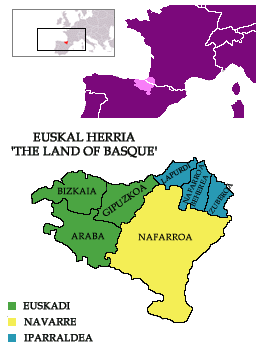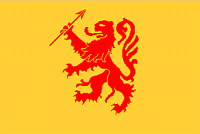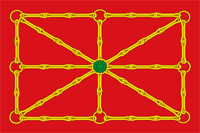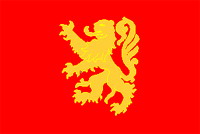
The northern Basque Country (Iparralde) together with Euskadi and Navarre form a historic and cultural reality known as Basque Country. In early times, it was called Vasconia or Euskal Herria (as always said in the Basque language). The political representations of this reality over times were the Duchy of Vasconia and the Kingdom of Pamplona-Nájera. Today, the Basque Country is divided into two states, France and Spain and inside the Spanish state, it is divided as well into two autonomous communities: Euskadi and Navarre.
The continental Basque Country is known as Iparralde (The North in Basque), which is also called French Basque Country. There are 264.000 inhabitants (year 1999) and it has 2978 square kilometres. It comprises the following territories: Lapurdi (Labourd), Nafarroa Beherea (Lower Navarre) and Zuberoa (Soule). In the 18th century, the French Revolution put an end to the statutory institutions of the continental Basque regions and even today, they have not yet their own political entity.
 This is so that the northern Basque
Country doesn't exist in the map of France, nor the former Basque regions that are comprised in it. The whole territory together with the Béarn are today part of the Atlantic Pyrenees Department which in turn belongs to region of Aquitaine. Euskara is not an officially recognised language together with French. In legal terms, Euskara does not exist.
This is so that the northern Basque
Country doesn't exist in the map of France, nor the former Basque regions that are comprised in it. The whole territory together with the Béarn are today part of the Atlantic Pyrenees Department which in turn belongs to region of Aquitaine. Euskara is not an officially recognised language together with French. In legal terms, Euskara does not exist.
In a non-binding referendum that was recently carried out in the three territories of Iparralde, the vast majority of the northern Basque inhabitants showed that they were in favour of their own Basque Department. Although the Gallic authorities have promised the creation of a Basque Department on several occasions,
this issue is still unresolved. According to the population belief, the establishment of that department would be essential for the linguistic, cultural and economic boost of the northern Basque Country.
Iparralde is economically divided into two sectors: the coast and inland. The coastal towns are mainly engaged in fishing and tourism while inland population depends primarily on agriculture and livestock. The coastal area is the most populated in contrast to the interior of the territory, where there is a small population.
At the end of the 19th century, 65% of the Basque-French population spoke Eskara. Now, the situation is critical. According to the records of 1996, only 26.4% of the inhabitants (70,000) speaks the Basque language (mainly elder people and rural inhabitants). 9.3% understands it, but cannot speak it (25,000 inhabitants) and the remaining 64,2% (169,000 inhabitants) speaks Gascon or only French. If the co-official status of the Basque language together with French is not achieved and Euskara does not receive any support for education, it is estimated that the language will have completely disappeared from the northern Basque Country within 40-50 years.
For more information about the French-Basque country, please visit the website of the Pyrénées -Atlantiques Department

Lapurdi (la'purdi): Labort (in Spanish), Labourd (in French), is also called Laburdi (la'burdi) in Basque. It has 859 square kilometres and a population of 219,000 inhabitants (1999), that is mainly settled in the coastal tourist area. It was part of the lands that belonged to the Aquitaines, where the Roman city of Lapurdum (Bayonne) was established and that gave its name to the region. This territory is the westernmost continental area and it is located on the Atlantic coast. Labourd has the following famous cities: Miarritze (Biarritz), which is the tourist capital of Iparralde. Hendaia (Hendaye) and Donibane Lohizune (do'niba'ne lo'izu'ne: Saint-Jean-de-Luz). This region is a very important French tourist area.
|
Territory |
Lapurdi (Labourd) |
|
Year |
1999 |
|
Employees |
82.245 |
|
Primary Sector |
1.992 |
|
Industry |
17.205 |
|
Services |
63.048 |
|
Employed (%) |
100 |
|
Primary Sector (%) |
2,4 |
|
Industry(%) |
20,9 |
|
Services (%) |
76,7 |
After the emergence of Common Euskara during the Frankish-Visigothic age, the territories of Labourd and Lower Navarre spoke a class of Euskara, which was very similar to the language spoken by the peninsular Navarreses. Euskara was influenced in those northern areas by Gascon for centuries, what gave rise to a new dialect: the Navarrese-Labourdin dialect. According to the records of the year 1996, 19.4% of the population is Basque-speaker; 9% understands it, but cannot speak it and the remaining 71% speaks Gascon or only French. The capital of Labourd is:
* Baiona (bay-óna; Basque form)
* Bayonne (French form)
* Bayona (Spanish form)

Nafarroa Beherea (na'farro'a be'ere'a): Baja Navarra (in Spanish), Basse-Navarre (in French), Lower Navarre (in English), is also called Behe Nafarroa (be'e na'farro'a) and Baxenabarre (ba'shena'barre) in Euskara. This territory is located between Labourd (to west) and Soule (to east). It covers an area of 1,348 square kilometres and has a population of 30,000 inhabitants (1999) that is concentrated in rural areas.
Lower Navarre was part of the lands that belonged to the Aquitaines during the Roman age. The Castilian invasion of the Kingdom of Navarre in the 16th century caused the final division of the Navareses into different political entities. Although the Navarreses from both sides of the Pyrenees have lived separately for almost five centuries, the Lower Navarreses still keep the same flag of the old Kingdom of Navarre.
|
Territory |
Nafarroa Beherea (Lower Navarre) |
|
Year |
1999 |
|
Employees |
11.526 |
|
Primary Sector |
3.058 |
|
Industry |
2.467 |
|
Services |
6.001 |
|
Employed (%) |
100 |
|
Primary Sector (%) |
26,5 |
|
Industry (%) |
21,4 |
|
Services (%) |
52,1 |
The Navarrese-Labourdin dialect is spoken in Lower Navarre, just the same as in Labourd. It is the Basque territory with most Basque-speakers in proportion to its population. According to the records of 1996, 69% of its inhabitants speaks Euskara; 11% understands it, but cannot speak it and the remaining 19% speaks Gascon or only French. The capital of Lower Navarre is:
* Donibane Garazi (doníbané garási - Basque form)
* Sant Jean-Pied-de-Port (French form)
* San Juan Pie de Puerto (Spanish form)

Zuberoa (zu'bero'a): Sola (in Spanish); Soule (in French) is also called Xiberoa (shi'bero'a) in the Souletin dialect of Euskara. It is the easternmost territory of Iparralde and the one that maybe has a stronger identity. Soule has 15,000 inhabitants (year 1999) and 771 square kilometres. Its population is mainly rural.
The region was also part of the lands that belonged to the Aquitaines in the past, and today it is spoken the Souletin dialect of Euskara. In early times, the class of Euskara that was spoken in Soule was very similar to the one spoken by the peninsular Navarreses. This dialect has some particular features, like the fact of have been influenced by Gascon (the same as it happened in the other territories) and also by the Aragonese language (currently spoken in the province of Huesca, Spain) during its dialectal development. The Souletin dialect keeps as well archaic grammatical forms that bring the language closer to the Western dialect or Biscayan dialect.
|
Territory |
Zuberoa (Soule) |
|
Year |
1999 |
|
Employees |
6.059 |
|
Primary Sector |
1.301 |
|
Industry |
1.798 |
|
Services |
2.960 |
|
Employed (%) |
100 |
|
Primary Sector (%) |
21,5 |
|
Industry (%) |
29,7 |
|
Services (%) |
48,9 |
The Souletin dialect is the most phonetically differentiated from the rest of the Basque dialects due to its strong Germanic component (notice the sound /ü/ and in some cases the sound /ö/) that Gascon introduced by means of its influence. It is likely that the most beautiful songs in Euskara were composed in this dialect.
According to the records of the year 1996, 51.6% of the population is Basque-speaker. 15% understands it, but cannot speak it and the remaining 34% of the inhabitants speaks Gascon or only French. The capital of Soule is:
* Maule (máule, Basque form)
* Mauléon (French and Spanish form)
Share this page!




